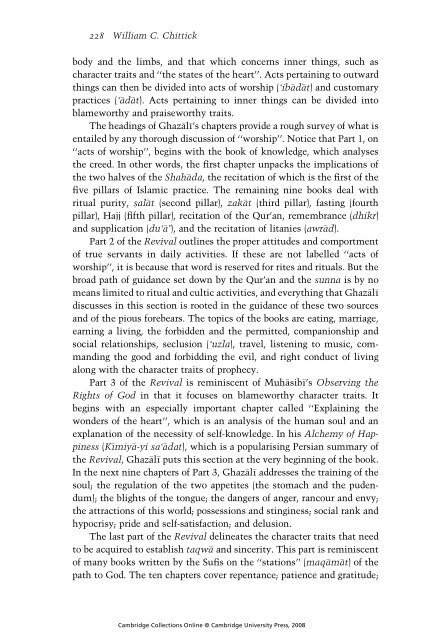Abdal Hakim Murad - The Cambridge Companion to Islamic Theology
You also want an ePaper? Increase the reach of your titles
YUMPU automatically turns print PDFs into web optimized ePapers that Google loves.
228 William C. Chittick<br />
body and the limbs, and that which concerns inner things, such as<br />
character traits and ‘‘the states of the heart’’. Acts pertaining <strong>to</strong> outward<br />
things can then be divided in<strong>to</strong> acts of worship (‘ibadat) and cus<strong>to</strong>mary<br />
practices (‘adat). Acts pertaining <strong>to</strong> inner things can be divided in<strong>to</strong><br />
blameworthy and praiseworthy traits.<br />
<strong>The</strong> headings of Ghazalı’s chapters provide a rough survey of what is<br />
entailed by any thorough discussion of ‘‘worship’’. Notice that Part 1, on<br />
‘‘acts of worship’’, begins with the book of knowledge, which analyses<br />
the creed. In other words, the first chapter unpacks the implications of<br />
the two halves of the Shahada, the recitation of which is the first of the<br />
five pillars of <strong>Islamic</strong> practice. <strong>The</strong> remaining nine books deal with<br />
ritual purity, s _<br />
alat (second pillar), zakat (third pillar), fasting (fourth<br />
pillar), H _<br />
ajj (fifth pillar), recitation of the Qur’an, remembrance (dhikr)<br />
and supplication (du‘a’), and the recitation of litanies (awrad).<br />
Part 2 of the Revival outlines the proper attitudes and comportment<br />
of true servants in daily activities. If these are not labelled ‘‘acts of<br />
worship’’, it is because that word is reserved for rites and rituals. But the<br />
broad path of guidance set down by the Qur’an and the sunna is by no<br />
means limited <strong>to</strong> ritual and cultic activities, and everything that Ghazalı<br />
discusses in this section is rooted in the guidance of these two sources<br />
and of the pious forebears. <strong>The</strong> <strong>to</strong>pics of the books are eating, marriage,<br />
earning a living, the forbidden and the permitted, companionship and<br />
social relationships, seclusion (‘uzla), travel, listening <strong>to</strong> music, commanding<br />
the good and forbidding the evil, and right conduct of living<br />
along with the character traits of prophecy.<br />
Part 3 of the Revival is reminiscent of Muh _<br />
asibı’s Observing the<br />
Rights of God in that it focuses on blameworthy character traits. It<br />
begins with an especially important chapter called ‘‘Explaining the<br />
wonders of the heart’’, which is an analysis of the human soul and an<br />
explanation of the necessity of self-knowledge. In his Alchemy of Happiness<br />
(Kımiya-yi sa‘adat), which is a popularising Persian summary of<br />
the Revival, Ghazalı puts this section at the very beginning of the book.<br />
In the next nine chapters of Part 3, Ghazalı addresses the training of the<br />
soul; the regulation of the two appetites (the s<strong>to</strong>mach and the pudendum);<br />
the blights of the <strong>to</strong>ngue; the dangers of anger, rancour and envy;<br />
the attractions of this world; possessions and stinginess; social rank and<br />
hypocrisy; pride and self-satisfaction; and delusion.<br />
<strong>The</strong> last part of the Revival delineates the character traits that need<br />
<strong>to</strong> be acquired <strong>to</strong> establish taqwa and sincerity. This part is reminiscent<br />
of many books written by the Sufis on the ‘‘stations’’ (maqamat) ofthe<br />
path <strong>to</strong> God. <strong>The</strong> ten chapters cover repentance; patience and gratitude;<br />
<strong>Cambridge</strong> Collections Online © <strong>Cambridge</strong> University Press, 2008



